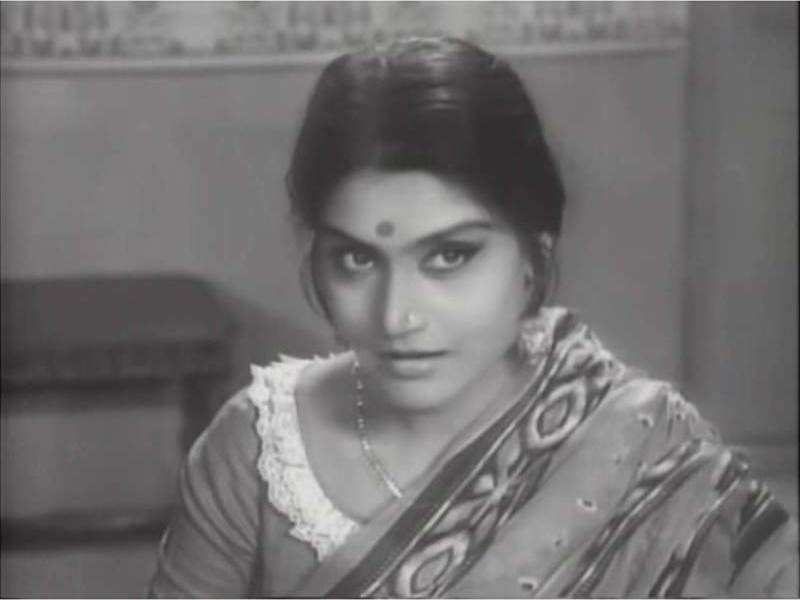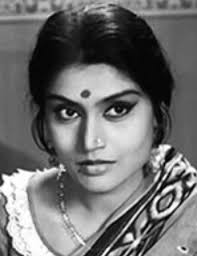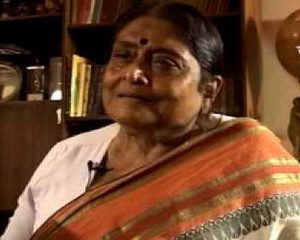( The veteran actor and singer, who passed away at the age of 84 last month, nourished the tradition of choir music in India and took it to the heights of artistic sophistication. )

As a 5 year old kid in a ‘Kendriya Vidyalaya’ School in Bhopal where I first heard the famous Hindi group song ‘Waqt ki Awaz hai mil ke chalo’, I could have scarcely imagined that one day I would write about the woman who made that famous. To the generation who grew up watching Doordarshan in the 80s the group songs performed with men wearing kurta-pyjamas on one side and women wearing sarees on the other, was a common sight. This entire tradition in India of choir singing was primarily nourished and taken to heights of artistic sophistication through the long and dedicated efforts of one woman and her group. This writing is to pay my tribute to her – Ruma Guha Thakurta who passed away early last month (June ’19). Upon her death, some among the national print media reported that in brief, but mainly highlighting her merely as Kishore Kumar’s first wife. Ruma-di, as she was affectionately known as, was much more that. It was for this reason that I felt impelled to write about her as I thought a lot needed to be said about her contributions, particularly choir music, and the silent but impassioned dedication she had for her work. I myself, had derived immense joy from the prolific output of the Calcutta Youth Choir, which was Ruma-di’s life’s work. Indeed, over the years I had developed an affinity, almost an identification with Calcutta Youth Choir, much like how I felt with another great Calcuttan cultural institution – the theatre Group Nandikar – founded by Ajitesh Bandyopadhyay and later nourished by the wonderfully gentle Rudraprasad Sengupta, in the same way one feels with a football club or – in these days – an IPL team.
Born Ruma Ghosh, she was exposed to music from early age through her mother who was a classically trained singer. As a child Ruma was also sent to Uday Shankar Academy in Almora to learn dance. She had moved to Bombay as a kid and played a 10 year old kid in ‘Jwar Bhata’ in 1944, the film famous for being Dilip Kumar’s debut work. Even as a kid she was active in the Bombay IPTA (the Indian People Theatre Association), the cultural front of the left-leaning intellectuals and artists. which then was very vibrant. In Bombay she also underwent training under Ustad Abdul Rehman Khan Sahab and acted and sung as a teenager in several Hindi films, credited as Rumadevi, like Mashal directed by Nitin Bose (whom Dilip Kumar considered as his Guru), and Chetan Anand’s Afsar. It was when she was 16 that one day at the Bombay Talkies (the great Bengali-dominated film establishment in Bombay founded by Himanshu Rai and having several other Bengali icons like Rai’s wife Devika Rani, Shashadhar Mukherjee, and Mukherjee’s brother-in-law Kumud Ganguly known to the world as Ashok Kumar) she was introduced to Abhas Kumar Ganguly – Kishore – the youngest of the Ganguly brothers of Khandwa. This later led to their marriage. It was the time when Kishore was acting as well as singing mostly for himself and as voice of Dev Anand for the Navketan productions. They had their son, Amit Kumar, but after a few years the couple separated in 1958 with Kishore marrying Madhubala. Ruma’s subsequent marriage with Arup Guha Thakurta was a very stabilising influence in her life.
But the year 1958 would also mark the beginning of something that would fully keep Rumadi occupied for rest of her life – the starting of the Calcutta Youth Choir. Till then secular choir singing was almost unknown in India. Salil Chowdhury, a great creative genius who is unfortunately known only as a film composer outside Bengal, but one who had penned and scores several memorable and timeless songs known as ‘Ganasangeet’ or People’s Songs right from his early twenties through his involvement with the IPTA. He had also set up, as part of cultural movement, the Bombay Choir. But in 1958, possibly because of several preoccupations that Salil-babu had, including mainstream film compositions – indeed his grandest mainstream success ‘Madhumati’ came that year – he wanted to, as it were, pass this cherished dream of his to someone who could make it his / her own dream and give oneself fully to it. And he inspired Ruma to do that. He had a wide disciple base in Calcutta and asked Ruma to organise them into a choir. Additionally, Ruma was guided in this by her maternal uncle, the redoubtable Satyajit Ray. Thus the Calcutta Youth Choir was started with Ruma, Salil Chowdhury and Satyajit Ray recorded as founders, and Ray the first President.
The CYC which at its peak had hundreds of active member-performers has done more than 5000 shows around the world in last 60 years. It brilliantly enlivened some of the finest songs from the oeuvre of Rabindra Sangeet, Dwinjjendralal Roy, Nazrul, Atul Prasad, and of course Salil Chowdhury. I have thoroughly loved ‘Amar Pratibader Bhasha’ (the Salil Chowdhury number first written in 1948) in its CYC rendition, the pacifist anthem ‘Aaj Jawto Juddhabaj’ written by Sibadas Bandyopadhyay and for which music was arranged by the formidable V. Balsara – the Parsi composer and an extraordinarily talented instrumentalist who left Bombay after a brief career as a music director in films to make Calcutta his home, and who for the sake of worshiping music was often content to work under other composers or even play an instrument for them. The CYC rendition of Bhupen Hazarika’s Ganga – both in Bengali as well as Hindi – are unique renditions of that great song. ‘Waqt Ki Awaz’ and several other Hindi songs of Prem Dhawan were also made immortal by CYC. Immortalised too was the song penned by Shailendra ‘Tu zinda hai to zindagi ki jeet mein yakeen kar’. The Hindi-listeners would also find great delight in the INA collection brought out by the CYC in mid-nineties, including of course ‘Kadam Kadam badhaye Ja’. Equally fascinating were the Bengali patriotic (Deshatmabodhak) songs from the CYC stable. Indeed my all-time favourite patriotic number, ‘Dhana Dhanno Pushpa Bhara’ – the iconic DL Roy song, which in more than a century now, has been interpreted by innumerable artists including Roy’s own son – the prodigious and versatile Dilipkumar Roy, and likes of Hemanta Mukhopadhyay, is also immensely charming in its CYC form with Ruma-di in the lead. The sheer thrill I always experienced at some of these Ganasangeet renditions was also felt by children and staff at my institution Parivaar and many of these CYC numbers as also Salil-da’s ‘Ghum Bhangar gaan'(literally ‘songs for breaking sleep’) like ‘Dheu uthche’ and ‘Manbo na’ (also rendered brilliantly by Manna Dey) were regular items at our cultural events.
The CYC was also internationalist in its vision and outlook. It adapted and celebrated the work of world figures like Paul Robeson, Pete Seeger, and Harry Belafonte. For everyone who had been present on the occaasion, it was an unforgettable experience to see the CYC perform ‘Swagato Mandela’ at the Eden Garden’s at the historic occasion of Nelson Mandela’s visit to Kolkata in 1990. Ruma-di, later in an interview, had told that this song had been prepared in one night. It is said that Indira Gandhi had a fondness for the CYC. It was she who formally released the ‘Waqt ki Awaz’ album.
The CYC also did several innovations in choir structures and introduced dance in some of its presentations. Always managing with extremely meagre resources the CYC travelled widely to villages and small towns in buses and trains. They would also always lend their voice to people’s struggles and movements and did many shows on a regular basis for workers’ organizations and other people-based groups. A high point in their journey was when they won an International Prize at Copenhagen in 1974.
Besides all this, Ruma Guha Thakurta had been an actor of no mean abilities and received awards for many of her screen performances. She acted in two of Satyajit Ray’s films – Abhijan and Ganashatru – indeed, it was in Ganashatru, that I first saw RGT on screen. Even while leading CYC she did occasional playback in Bengali cinema, including one in Ray’s ‘Teen Kanya’. My favourite film playback of hers is the Bengali duet with Kishore Kumar (when she was still married to him) ‘Ei to hethay’ from the 1956 film ‘Lukochuri’, a marvellous composition by Hemanta Mukhopadhyay.

During the Tagore sesquicentennial celebrations in 2011, the CYC had brought out albums of Rabindra Sangeet with lyrics adapted and performed in Hindi. I heard that they intended to produce similar albums in many other Indian languages. I found this project very close to my heart as a key theme that has always driven me is to bring Indians of different regional linguistic cultures come close to each other and identify with all sub-cultures of our land as their own. I was considering trying to be of some help to the CYC by connecting them with a philanthropist I knew, who usually took interest in such matters, and thought who might appreciate the ‘national integration value’ of this project. But due to inertia I did not act in time and it has been my lasting regret that I was not more proactive in the matter.
It is simply stupendous as to how Ruma-di successfully kept together such a huge ensemble for such a long time in a resource-crunched scenario. I believe that was largely due to her mother-heart which acted as a glue. Without that it is not possible to keep such a large number of people together with enduring commitment. Choir much like theatre, is something which entails a certain degree of selflessness from its members and is often characteristised by nameless contribution from its members who see it as a calling than a profession. For a long time CYC did not even have a place of their own to practice and rehearse, until they were provided a land by the State Government.
As someone who spent his childhood in Bhopal an interesting piece of trivia for me is that Rumadi also had a hand in recommending a 12 year old Bhopal girl Jaya Bhaduri, who was then visiting Kolkata with her family, to Satyajit Ray, resulting in Jaya’s debut film ‘Mahanagar’, directed by the maestro. Who knows whether Jaya Bhaduri would have joined films without that experience.
Rumadi’s life’ work – the CYC – one hopes, will be carried forward by the band of devoted idealists she groomed over a long time. In one of her last interviews she was confident that the CYC will keep going strong even when she is no more. Apart from CYC, her musical legacy goes on with her son Amit Kumar, who had been a wonderful loving and caring son to his mother, and her daughter from her second marriage Sromona.

To me the choir music in India is synonymous with the name of Ruma Guha Thakurta. In my opinion she was a major cultural figure of our country with a far greater and enduring impact than so many other more celebrated personalities. Her work with the CYC has something solid at the core, possessing a dimension of timelessness and universality. In her person, she seemed to be someone who wanted to bring out all her gifts, and treasures of her immediate culture, to the benefit and use of her whole country, and humanity. I would like to remember her as a great Bengali, and an even greater Indian.